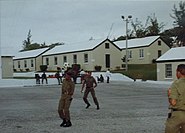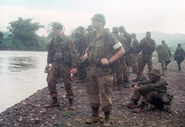| The Bermuda Regiment | |
|---|---|
|
File:Bermuda Regiment badge.jpg Cap Badge of the Bermuda Regiment | |
| Active | September 1, 1965 |
| Country | Bermuda (United Kingdom overseas territory) |
| Branch | Army |
| Type | Line Infantry |
| Role | Internal Security |
| Size |
One Battalion ~609 soldiers |
| Garrison/HQ | Warwick Camp |
| March | Quick - Bermuda |
| Anniversaries | 21 November 1965, presentation of the first colours. |
| Commanders | |
| Commanding Officer | Lt. Col. Michael Foster-Brown |
| Colonel-in-Chief | HRH The Duchess of Gloucester |
| Honorary Colonel | Col. Eugene Raynor |
The Bermuda Regiment is the home defence unit of the British Overseas Territory of Bermuda. It is a single territorial[1] infantry battalion that was formed by the amalgamation in 1965 of two originally voluntary units, the all white Bermuda Volunteer Rifle Corps (BVRC) and the mostly black Bermuda Militia Artillery (BMA).
History[]
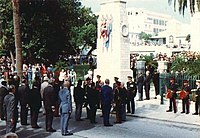
Remembrance Day parade, at the cenotaph, in the City of Hamilton, 1990.
The BVRC and the BMA were raised at the end of the 19th century in order to allow the Regular Army component of the garrison to be reduced. This was done primarily as an economic measure, though the regular units withdrawn were required for the build-up of what would become the British Expeditionary Force. In 1953, when the coastal artillery batteries were taken out of use, the BMA, while still wearing the Royal Artillery cap badge, converted to the infantry role. This left the Colony wastefully maintaining two separate infantry units. After closure of the Royal Navy's dockyard commenced in 1951 (a process that lasted 'til 1958, leaving only a small naval base, HMS Malabar, within the former dockyard),[2] the military garrison, which had existed primarily to protect the Royal Navy base, was also closed. The last regular unit (a detachment from the DCLI) was withdrawn in 1957, and the two Bermudian territorials ceased to have any military role under Imperial defence planning (with 1953 being the last year an Imperial Defence Plan, under which their roles were assigned, was issued). Although the colonial government had only formed the two units at the behest of, and under pressure from, the British government, it chose to continue maintaining them entirely at its own expense.
The amalgamation of the forces took place on 1 September 1965. The new Bermuda Regiment's stand of colours was presented by Princess Margaret. Princess Margaret presented a second stand of colours to replace the first in 1990, to mark the Bermuda Regiment's 25th anniversary. The Bermuda Regiment is not entitled to inherit the battle honours of the units amalgamated into it, they are not displayed on its colours, and are rarely mentioned. The battle honours it inherits from the BVRC, all from World War I, are Ypres 1915, Neuve Chapelle, Loos, Somme 1916, Ypres 1917, Lys, Hindenburg Line, Messines 1917, Somme 1918 (the BMA had no battle honours specific to itself to hand down, although its contingents had taken part in battles such as Vimy Ridge and the Somme, and as part of the Royal Regiment of Artillery, it had the honour ubique; everywhere). This is ostensibly due to the gap formed by the disbandment of the BVRC and the formation of the Bermuda Rifles, although a skeleton command structure remained after the BVRC's 1946 disbandment, and was brought back up to strength to form the Bermuda Rifles in 1951. Originally a volunteer unit, the BVRC (and BMA) had also been briefly disbanded after the First World War. On that occasion, it had been re-embodied as a territorial (a process that had taken place in Britain and Ireland in 1908, when the Volunteer Force, Militia, and Yeomanry had been merged, their units linked to Regular Army regiments, and terms of service introduced for recruits, who were no longer permitted to quit their service with 14 days notice) although it had continued to be titled as a volunteer rifle corps 'til 1951.
The latest set of Colours were presented by HRH Duchess of Gloucester, GCVO at the National Sports Centre on 13 November 2010. The former set will be retired to the Bermuda National Museum, before being formally laid up in the Warrant Officers' and Sergeants' Mess. The third set of Colours have been donated by the Bermuda Regiment Charitable Trust.
Badge[]
Bermuda Volunteer Rifle Corps badge
The Badge of the Bermuda Regiment draws elements from those of the BMA (Royal Artillery) and the BVRC.
The badge of the Bermuda Regiment combines elements from those of the Royal Regiment of Artillery, and the BVRC.
The full badge, as displayed on the Colours, features two crossed cannons creating an X behind a Maltese cross (the symbol of rifle regiments in the British Army, and used on the white metal BVRC badge), set on a circular shield with "THE BERMUDA REGIMENT" inscribed around it, and the whole enclosed within a wreath and surmounted by the Crown.
The cap badge is bi-metal - all brass, except a white metal Maltese cross, which is set inside the wheel of a cannon (taken from the badge of the Royal Artillery), with a half-wreath about the lower hemisphere of the badge. Flashes, and other colour marks used on dress and elsewhere (such as backgrounds on signs about Warwick Camp) are red and blue, reflecting the colours of the Royal Artillery, but the stable belt (issued only to permanent staff, officers and senior ranks) worn is rifle green, with black edges, referring to the colours used by the BVRC. [2]
Dress[]
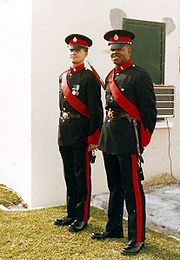
Bermuda Regiment Warrant Officers in the No. 1 dress

Bermuda Regiment Potential Non-Commissioned Officer (PNCO) Cadre Promotion Parade, Warwick Camp, Bermuda. June, 1994.
The dress uniform itself is closer to the old Royal Artillery pattern, and to the generic No. 1 full-dress uniform used by most British regiments today, being composed of dark blue, almost black, tunic and trousers, and differing only in the red cuffs and collar added to the tunic. The trousers have a broad red stripe running down the outside of each leg. A generic dark blue peaked cap with red hat band is worn with this uniform. During the summer months, British Army No. 3 Dress was worn (i.e., the same uniform, with the exception of a generic, white, tropical-weight tunic). Most of the public parades for which dress uniform is worn take place during the summer months. Due to the budgetary restraints resulting from the current economic recession, the No. 1 uniform is no longer on general issue, and can be worn only with the permission of the Commanding Officer. The No. 3 uniform is now worn for ceremonial pareds year round.

Bermuda Regiment Warrant Officer in the old DPM No.9: Tropical Combat Dress
The combat uniform is now the British Army Multi-Terrain Pattern. For much of the Regiment's history, it's dress included a mixed collection of British uniform items. As with its predecessors, the Bermuda Regiment has a tradition of wearing temperate uniforms, including combat jackets and pullovers, for much of the year, and tropical uniforms during the summer months. This is a result of the peculiar climate of Bermuda. For many years, and unusually for an infantry unit, the Regiment wore the Denison parachute smock[3] which it inherited from its predecessors, only adopting the 1968 pattern DPM combat jacket in the 1980s (which it issued into the new millennia, although the 1968 uniform actually became obsolete with Regular British Army regiments in the 1980s). Green shirts and lightweight combat trousers began to be supplemented by DPM tropical uniforms in the 1980s, and by the mid nineties had been entirely replaced by them (although the green kit, like the Denison smocks, was handed down to the Regiment's Junior Leaders, and to the Bermuda Cadet Corps, which continued to wear it). The tropical DPM uniformed continued to be issued for some time after its replacement in Britain by the Soldier 95 uniform. The beret worn is the dark blue one worn by the Royal Artillery, and by various British Army units not authorised to wear distinctive colours of their own.
Little use is made of Service Dress, which is only issued to a handful of permanent staff members, though which is interesting as the colour varies slightly from the standard British Army khaki (being greener), and as, during the summer months, the long trousers might be replaced with shorts. The Bermuda Regiment service dress is composed of jacket and trousers, worn with an olive green peaked cap, tan shirt, and tie. Whereas its predecessors often used tropical weight service dress during the summer months, it uses the same uniform worn in shirt sleeve order - usually, a short-sleeved tan shirt with no tie, whether worn with long trousers or shorts of the same weight and colour. A stable belt is worn in shirt sleeve order. Mess dress is also worn for many functions by members of the Officers' Mess, and of the Sergeants' (and Warrant Officers') Mess.
Organisation[]
Leadership[]
A Command Centre during IS training.

PNCO Cadre train in Internal Security (IS) role.
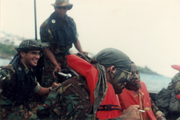
Bermuda Regiment soldiers aboard a motor boat, off the North Shore of Bermuda, 1996.
As Bermuda is a British overseas territory, and defence is therefore the responsibility of the United Kingdom, the Bermuda Regiment is under the control of the Governor and Commander-in-Chief of the island. However, pay and financing is the responsibility of the Ministry of Labour, Home Affairs and Housing. The Bermuda Regiment is listed in the British Army Order of Battle as number 28 in order of precedence.
On its formation, the Regiment's Honorary Colonel was HRH Princess Margaret, Countess of Snowdon, who became Colonel-in-Chief in 1984. After her death in 2002, the position was assumed, in 2004 by HRH The Duchess of Gloucester. The unit is directly commanded by a Lieutenant-Colonel, as is typical of a battalion in the British Army, who is appointed by the Governor upon the advice of a Defence Board. Brian Gonsalves was appointed on 28 May 2009, to serve for a standard three-year tenure. In some cases that tenure can be extended by the Governor for a further year. In Lieutenant Colonel Gonsalves case, he filled the role until passing command to Lieutenant Colonel Foster-Brown in June 2013.
Manpower and structure[]
The Regiment's original strength was about 400, including all ranks. Following discipline problems during an exercise in the West Indies, a report on the unit was commissioned from Maj-General Glyn Gilbert, the highest-ranking Bermudian in the British Army. Maj-Gen. Gilbert also took into account the difficulties the Regiment had experienced in meeting its obligations when embodied during the civil unrest of 1977. He made a number of recommendations, including the increase of the Regiment's strength to a full battalion of about 750, with three rifle companies (A, B, and C) and a support company. Initially, the three rifle companies rotated through the role of training company. Eventually, C Company was renamed permanent Training Company. Recruits spent their first year in Training Company, then transferred as a unit to whichever rifle company was losing its third-year conscripts, or were reassigned individually to other sub-units.
Today, following a steady reduction in the number of 18-year-old males eligible for conscription each year, the Regiment has a strength of approximately 609, with a full-time administrative component of 30. After a review in the late 1990s, the Bermuda Regiment had its establishment reduced to its present format:
- A Company: Second and third year soldiers.
- Training Company: First year soldiers.
- Support Company: Boat Troop, Regimental Police, Signals, Guns/Assault Pioneers, Medics and Motor Transport section.
- Quartermasters Company: Logistics and stores.
- Band Company: Music and Ceremonial.
One of the units amalgamated into the Bermuda Regiment, the BMA, was nominally an artillery unit, although it had converted to the infantry role in 1953. Other than a ceremonial Gun Troop, equipped with two 25-pdr. field guns, the Bermuda Regiment is wholly an infantry unit.
Conscription[]

Recruits clean their Mini-14 rifles, prior to a shoot at Warwick Camp, during the 1994 Recruit Camp.
The majority of the Regiment is made up of conscripts, making it unique among all of the land forces still under the British Crown. Conscription is based on a random lottery of men through the ages of 18 to 23, with exemptions granted to Police and Prison officers, members of the British regular forces (or men who have served for two years), church ministers, prisoners or those who have been judged to be of "unsound mind". Temporary deferment is granted for full-time students (attending either the Bermuda College or schools abroad), for the length of their studies, and individuals currently medically unfit but likely to become fit again. Conscientious objectors have the opportunity to either serve in a non-combatant role or perform an alternative community service chosen by the Governor.
This practice (of conscription) is frequently criticised by both Bermudians and aware non-Bermudians, particularly for its sexism and its similarity to slavery (a sensitive issue given the historic background of Bermuda), and has been noted in the British Parliament.[3][4][5][6] It receives support from the community, however, and is hailed for causing interaction between social and racial groups. A recent Bermuda Supreme Court decision has upheld that conscription is a lawful process, as presently administered by the Defence Department, although it required an earlier Supreme Court decision in 1995 to establish conscientious objection on an equal basis with that obtaining in Britain during conscription. Moral issues aside, however, this leaves the force dependent on the qualities of senior officers,[citation needed] whereas similar units – the British Army, in particular, upon which the Regiment is modelled – emphasise the initiative of junior members.
The local government, as of 2013, has committed to ending conscription, although it is likely to be phased out gradually in order to prevent the manpower of the battalion (which had already seen its numbers fall below strength, from four to three companies, as a delayed result of birth rates decreasing following the Baby boom generation) plummeting.[7] Currently, three-quarters of the strength of the Bermuda Regiment is made up of conscripts, although many soldiers, whether they initially volunteered or were conscripted, elect to re-engage annually after their initial three years and two months term of service has been completed, with some serving for decades.[8]
Recent assessments[]
Towards the end of 2005 the Regiment took part in a fitness for role exercise this time in the form of an inspection by the Ministry of Defence. The review noted that equipment was substandard and major items would be deemed to be unserviceable by 2010 (half of the vehicles and signal equipment were noted to be "out of action") and that command and control was poor, though it also noted high morale and firearms proficiency.
A subsequent inspection in 2008 revealed that nothing had changed on the equipment issues, with the predicted consequences from the previous report being shown to be true. It was stated that Command and control was better than the previous study, albeit with some way to go yet.
Bermuda Regiment Junior Leaders and the Bermuda Cadet Corps[]
The Bermuda Regiment operated its own Junior Leaders programme for many years, until it was absorbed into the separate Bermuda Cadet Corps in the 1990s. The Junior Leaders had been part of the Bermuda Regiment, wearing the same cap badge and operating from Warwick Camp, whereas the Bermuda Cadet Corp was a separate organisation, operating through the island's Secondary Schools (having been reformed from the old Cadet Corps in 1965, at the same time as the amalgamation of the BVRC and BMA).
In 2012, due to financial constraints, the Bermuda Cadet Corps was disbanded and replaced by the resurrected Bermuda Regiment Junior Leaders.[9][10][11] Many of the Bermuda Regiment's officers, warrant officers, and NCOs began their service in the Junior Leaders, including the present Commanding Officer, Lieutenant-Colonel Brian Gonsalves.[12]
Operations[]
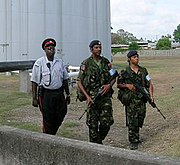
Bermuda Regiment armed with Mini-14's and Barbados Police conduct a joint patrol of an oil facility during the 2007 Cricket World Cup in Bridgetown, Barbados
The primary role of the Regiment has recently become disaster relief. Other roles include ceremonial duties, and supporting the Bermuda police department in internal security issues (both in the forms of riot-control and anti-terrorism). In 2001, following the September 11 attacks on the nearby United States, the Bermuda Regiment was embodied, taking over responsibility for the security of the Bermuda International Airport (Bermuda has always been a point of importance in trans-Atlantic aviation, and a large number of aircraft diverted to the Island when US airspace was closed) and other potential targets. In 2004 and 2005 the Regiment deployed to the Cayman Islands and Grenada to assist in post Hurricane Ivan restoration efforts.
The Bermuda Regiment successfully deployed a platoon of internal security trained soldiers to Barbados in 2007. There they took part in forming the security infrastructure for the WCC Cricket World Cup. They worked alongside soldiers from Barbados, Guyana, India and South Africa, in ensuring a secure environment for the Super 8 series of matches. Although little has been made of this deployment, this was the first time since the First World War that a formed unit from Bermuda has deployed overseas for an operation other than disaster relief (the Second World War drafts from the BMA, BVRC, and BVE were all absorbed into other units, and the cadre of officers and NCOs sent to Belize in the 1980s were attached to a battalion of the Royal Anglians).
The Regiment also performs a wide variety of community service operations, and is involved in many cultural events on the island, especially in parades.
Overseas connections[]

Bermuda Regiment & US Navy personnel at Camp Lejeune.
During World War I, the Bermuda Regiment's predecessor, the Bermuda Volunteer Rifle Corps (BVRC) sent two drafts to serve with the Lincolnshire Regiment on the Western Front. After the War, the connection to the Lincolns was made official. When the Volunteer Army had been reorganised into the Territorial Force in 1908, its battalions were linked to British (Regular) Army regiments which adopted paternal roles, providing the part-time units (which, in most cases, were renamed as additional battalions of the Regular Army regiment) with loaned warrant officers and NCOs, and sometimes officers, and taking other steps to give them the benefit of their experience. During war-time, the Territorials would send drafts of volunteers to the Regular battalions, or (once the restriction on sending Territorials overseas without their consent was lifted) the entire TA battalion might be sent. The role the Lincolns adopted with the BVRC was similar to that it played with its own TA battalions, although the BVRC remained a separate unit.
The BVRC again provided two drafts to the Lincolns during the Second World War. When the BVRC (renamed the Bermuda Rifles) was amalgamated with the Bermuda Militia Artillery (BMA), to create the Bermuda Regiment, the Royal Anglian Regiment, into which the (Royal) Lincolnshire Regiment had itself been amalgamated, continued the paternal role.
Throughout the Bermuda Regiment's history, the Royal Anglians have provided it with its Staff Officer, and with Permanent Staff Instructors (PSI), now called full-time instructors (FTI) Warrant Officers (WO2) for each of its companies, as well as other personnel on long-term and short-term attachments (although it should be noted that other Regiments have occasionally provided personnel on loan). Although the Bermuda Regiment has always managed to provide commanding officers from within its own strength, it has occasionally had to use seconded officers when unable to provide its own personnel to fill roles such as Second-In-Command (2-i-c), Adjutant, Regimental Sergeant Major (RSM), and Training Officer. Its first nine Adjutants (1965–1984) were all seconded from the Royal Anglians. Nine of its Regimental Sergeant Majors have been seconded, including three from the Royal Anglians. In 1996, its Second-in-Command, Staff Officer, and Adjutant were all on loan from the Royal Anglians. This frequent resort to seconded officers is due to a problem common to many Territorial units in Britain, also. These positions are all full-time ones, ideally filled by officers who volunteer from within the regiment, but whose service in these roles is restricted to three years. As relatively few officers can afford to leave their civil careers for three years, the problem is not so much caused by a lack of suitable officers, as a lack of willing ones.
The Lincolnshire Regiment was also affiliated to The Lincoln and Welland Regiment of the Canadian Army. Although joint training has occurred in the past, and short-term loans of NCOs from the Lincoln & Welland Regiment have been frequent (especially for Recruit Camps and Overseas Camps), numerous attempts to formalise the affiliation with the Bermuda Regiment have been unsuccessful.
Members of the ceremonial Gun Troop carry out occasional ceremonial training with the Royal Regiment of Artillery, which provides its Sergeant Major Instructor of Gunnery to conduct local courses, although the troop has no combat artillery role. As one of the units amalgamated into the Bermuda Regiment, the BMA, was an artillery unit (which history the Gun Troop commemorates), members of the Regiment are entitled to join the Royal Artillery Association (RAA), which has a branch located on the grounds of the former St. George's Garrison (which had been predominantly a Royal Garrison Artillery establishment). The Bermuda Regiment shares this unusual heritage of a combined infantry and artillery unit with the Royal Gibraltar Regiment.
Corps Warrant[]
In late 2001, the Bermuda Regiment and the Royal Gibraltar Regiment were presented with Corps Warrants dated 21 February 2000.
Other[]

Bermuda Regiment soldiers board a USMC CH-46 Sea Knight at USMC Camp Lejeune, in North Carolina, USA.
The Bermuda Regiment also developed a relationship with the United States Marine Corps, which had supplied a detachment to Bermuda for many years to guard United States Navy facilities. In addition to occasional training with the US Marines in Bermuda, the Bermuda Regiment used facilities and training areas of the US Marines' Camp Lejeune, and Camp Geiger for training, with the two rifle companies having been sent there every second year for their annual camps, and the Training Company's Potential Non-Commissioned Officers (PNCO) Cadre being sent there each June (it had previously been sent to Canada).
Following the increased usage of those bases, after 2001, by US forces preparing for deployment to Iraq and Afghanistan, the Bermuda Regiment moved the location for its annual camps to Florida, where it was developing a relationship with the Florida National Guard, although it has since recommenced the use of Camp Lejeune.
The location of annual camps in alternate years had been Jamaica, although in March, 2013, it was announced that a new location would be sought.[13][14] This was due to the cost of deploying to Jamaica, given the budgetary constraints, and as Jamaica provided little opportunity for training in Internal Security roles, such as is available at USMCB Camp Lejeune with its Military Operations in Urban Terrain (MOUT) facility.[15][16] The Bermuda Regiment's training in the USA and in Jamaica is self-contained, rarely involving local units, but friendly relationships have been developed with both the US Marine Corps, and the Jamaican Defence Forces (JDF). Specialist Bermuda Regiment sub-units, such as the Reconnaissance Platoon and the Medics, have trained with equivalent US Marine Corps units at Camp Lejeune.[17][18][19] Over the last few years, a relationship has also been developed with the Royal Gibraltar Regiment, and small detachments sent with that regiment on its annual training deployments to Morocco.[20] In 2007, for the first time, the annual camp was held in England, with detachments training at the Cinque Ports Training Area (CPTA); part of the Defence Training Estate (DTE) South-East, near Dover.[21][4]
Alliances[]
United Kingdom - The Royal Anglian Regiment
 Canada - The Lincoln and Welland Regiment
Canada - The Lincoln and Welland Regiment Jamaica - The Jamaica Defence Force
Jamaica - The Jamaica Defence Force
Commanding officers[]

Then-Lieutenant William White in Jamaica, 1996.
The Commanding Officer of the Bermuda Regiment (as also the Quartermaster, Training Officer, the Staff Officer (UK Loan Service), the Adjutant, the Aide-de-camp, and the Regimental Sergeant Major) is a full-time position, requiring those appointed to the role to take leave of their civilian employments. Originally, there was no limit to the term of a commander, but, following Lieutenant-Colonel Gavin Shorto's six years in the office, a three-year limit was introduced. The Commanding Officer is normally chosen from amongst the Majors of the Battalion, and is promoted to Lieutenant-Colonel. Following the tragic death of Major Christian Wheddon in a motor accident in England in 2012,[22][23] while training in preparation for assuming command, Lieutenant-Colonel Michael Foster-Brown, a professional soldier from The Rifles, assumed command in June, 2013, the first non-Bermudian to fill the role.[24][25][26]
- Lieutenant-Colonel John Brownlow Tucker, OBE, TD, MCP (ex-BVRC, ex-Lincolns, ex-BMA)
- Lieutenant-Colonel J. Anthony Marsh, DSO, OBE (ex-DCLI, ex-SAS).
- Lieutenant-Colonel Michael L. Darling, OBE, ED, JP
- Lieutenant-Colonel Colin C. Curtis, OBE, ED
- Lieutenant-Colonel Brendan O'D. Hollis, OBE, ED
- Lieutenant-Colonel Eugene Raynor, OBE, ED
- Lieutenant-Colonel A. Gavin Shorto, OBE, ED, JP
- Lieutenant-Colonel D. Alan Rance, OBE, ED
- Lieutenant-Colonel David A. Burch, OBE, ED, JP
- Lieutenant-Colonel Patrick Outerbridge ED
- Lieutenant-Colonel David Gibbons, OBE, ED
- Lieutenant-Colonel Edward Lamb ED
- Lieutenant-Colonel William White ED
- Lieutenant-Colonel Brian N Gonsalves ED
- Lieutenant-Colonel Michael Foster-Brown
Equipment[]
Rifles and shotguns[]
- Ruger Mini-14 self-loading rifle (in process of replacement as standard issue to riflemen)
- H&K G36 (in process of replacing the Mini-14 as standard issue to riflemen and the Uzi as second-tier weapon)
- L1A1 self-loading rifle (obsolete, but stocks still held)
- L85A1 SA-80 (used for familiarization training)
- Colt M4 (stocks obtained for trials to determine replacement for Mini-14 and Uzi)
- L42A1 sniper-rifle (a 7.62mm Lee-Enfield)
- No. 4, Mk. 1 (obsolete, but stocks still held)
- Mossberg 500 shotgun
- Greener shotgun (obsolete, but stocks still held)
Pistols and submachine guns[]
- Beretta 92 semi-automatic pistol
- Uzi submachine gun (in process of replacement by H&K G36)
- Sterling submachine gun (from HMS Malabar)
Machine guns[]
- FN MAG General-purpose machine gun
Internal Security (IS)[]
- ARWEN 37 riot weapon
- Federal Riot Gun (replaced by the ARWEN 37)
Artillery[]
Vehicles[]
- Toyota Land Cruiser light trucks
- Toyota Dyna lorries
- Rigid Raider boats
- Halmatic RHIB boats
Gallery[]
Many of the pictures displayed are dated, and at the very least over 12 years old.
See also[]
References[]
- ↑ Oxford English Dictionary: Definition of Territorial Army
- ↑ Naval History Homepage: Royal Navy post-World War 2 CHRONOLOGY, Part 2 - 1951-60. by Geoffrey B Mason, Lieutenant Commander, RN (Rtd) (c) 2007
- ↑ [1][dead link]
- ↑ Submission of Submission by Sergio Lottimore of Bermuda to the House of Commons
- ↑ Submission from Mr Robert Masters of Bermuda to the House of Commons
- ↑ House of Commons Foreign Affairs Committee Publishes Report on Overseas Territories, No. 26 (Human Rights)
- ↑ The Royal Gazette: Regiment plans incentives to attract volunteers, by Gareth Finighan. 7 June, 2013
- ↑ The Royal Gazette: Pitman’s 40 years in the Regiment recognised, By Ceola Wilson. 4 June, 2013.
- ↑ The Royal Gazette: Cadet Corp to be replaced as budget savings are made. Published 21 March 2012 (Updated 21 March 2012)
- ↑ The Bermuda Regiment: The Bermuda Cadet Corps
- ↑ The Bermuda Regiment: Request for volunteer instructors for the Junior Leaders
- ↑ Outward Bound, Bermuda. Our People. Board of Directors: Lt Col BN Gonsalves, ED, tacsc
- ↑ The Jamaica Gleaner: Bermuda Regiment To End Training Camps In Jamaica
- ↑ Jamaica Observer: Bermuda Regiment to end Jamaican training camps
- ↑ Special Operations.com The Camp Lejeune MOUT Facility. Familiarization Images.
- ↑ UNITED STATES MARINE CORPS: Marine Corps Base, Camp Lejeune Range and Training Regulations (BO 3570.1C) Standing Operating Procedures for Range Control
- ↑ The Globe: Bermuda recce team recon Lejeune. by Lance Corporal E.V. Walsh. April 20th, 1989
- ↑ Halifax Media Group, Jacksonville Caily News: Bermuda Regiment trains in casualty care at Camp Johnson. By THOMAS BRENNAN - Daily News Staff. Published: Tuesday, May 7, 2013 at 16:27 PM.
- ↑ Bermuda soldiers have medical training with local Marines. WCTI NewsChannel 12 (ABC affiliate), Bonten Media Group, Inc, New Bern, North Carolina
- ↑ The Bermuda Regiment: Courses - Local & Overseas
- ↑ Ministry of Defence Defence Training Estate (DTE) South-East: Public Information Leaflet
- ↑ The Oxford Mail: Army major named as A34 crash victim
- ↑ BBC News: Bermuda officer killed in A34 crash near Drayton
- ↑ The Royal Gazette: Foster-Brown takes over as Regiment CO
- ↑ The Royal Gazette: War veteran CO: Regiment offers a huge amount
- ↑ The Royal Gazette: Lt Col Foster-Brown takes over at Warwick Camp
External links[]
| Wikimedia Commons has media related to Bermuda Regiment. |
- Official Website of the Bermuda Regiment
- Official Website of the Bermuda Defence Department
- Foreign & Commonwealth Office: The Bermuda Regiment[dead link]
- Ministry of Defence: Royal Anglian soldiers boost Bermuda Regiment
- The Camp Lejeune Globe: Bermuda Regiment soldiers conduct training aboard MCB Camp Lejeune.
- St. Augustine Record: Bermuda Regiment will train at Camp Blanding. 1 May, 2002.
- Land Forces of Britain, The Empire & Commonwealth: The Bermuda Regiment[dead link]
- POTSI (archives): THE GREAT WAR - BERMUDIANS IN IMPERIAL(LESS LOCAL) UNITS, AND IN ALLIED FORCES.
- The Royal Gazette: "The closest thing to a plantation in Bermuda is Warwick Camp"
- Law Info: "Bermudian premier criticizes youths seeking to end draft "[dead link]
The original article can be found at Bermuda Regiment and the edit history here.








